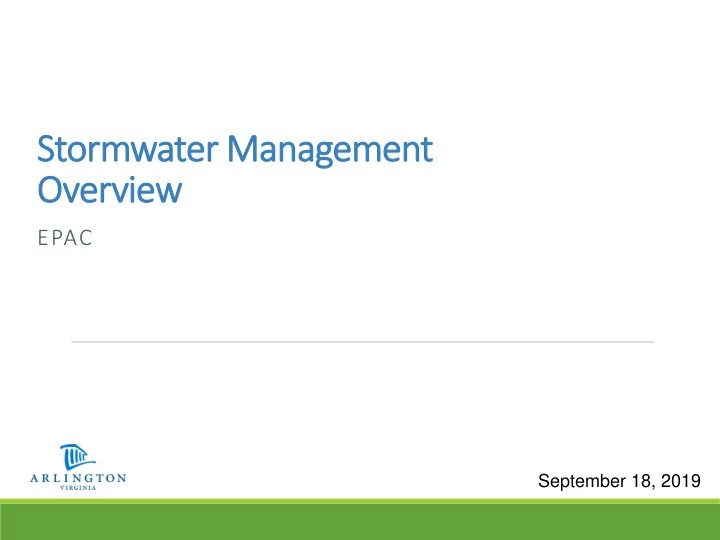

Stormwater Management Overview EPAC September 18, 2019
History of Development • Pre 1930s: Arlington was mostly farmland. Storm drainage was handled privately by landowners. • 1930-1950: Arlington became the fastest growing County in nation. Population 1920s 2007 1950s 1992 tripled due to federal workforce boom before & after World War II. 1930s Fairlington, 1943 Rosslyn, 1960s 2
Early Development In early days of Arlington’s expansion, there were no regulations for development projects. Stream network initially served as stormwater management system. As fast-paced development caused streams to erode & form gullies, 66% of streams were encased in stormwater pipes. Streams & floodplains were filled in or paved over, and could no longer convey flood waters safely during storms. 3
Overland Relief Because stormwater pipes have a specific capacity, systems are usually designed with overland relief for larger storms. Overland relief is a safe overflow path for runoff in larger storm flows, when storm sewers reach capacity. In some places in Arlington, buildings and homes were built close to the former streams after they were buried in pipes. When those pipes fill up, the pathway for overland relief in larger storms now flows through yards and, in some cases, homes. 4
Early System Design vs. Today Pre 1960s Today Designed for 12-15 year storm Designed for 10 year storm Overland relief not provided Overland relief required for 100 year storm Impervious area underestimated future Impervious cover based on land use and development development Easements not always required from Easements always required development 5
Advent of Stormwater Planning After south Arlington & Alexandria flooded in 60s & 70s, a flood channel was designed for lower Four Mile Run. Army Corps of Engineers completed channel in 1980. Arlington & Alexandria signed an agreement to begin to manage stormwater flows in Four Mile Run. Four Mile run flooding, 1960s and Walter Reed Bridge washed out, Hurricane Agnes, 1972 6
New Era of Regulated Development Original stormwater master plan in 1957. Many new state & federal laws were passed between 1970s & today. o Erosion & Sediment Control, 1976 o Stormwater Detention, 1976 o Floodplain Management, 1977 o Chesapeake Bay Preservation, 1992 o Arlington’s first stormwater permit, 1997 o Most recent updated Stormwater Management Requirements, 2014 However, by time these laws came into effect, much of Arlington already developed. 7
Recent Storms Over last few years, particularly in summers of 2018 & 2019, brief periods of intense rain have caused significant flooding damage and private property loss. These storms have caused public safety issues in the community and property damage. 8
Comparison of Storms Storms have varying degrees of impact based on the frequency, duration and rainfall intensity. Impact of a flashflood event, such as what occurred in 2006 & 2019, can be equal to or greater than a hurricane event that has both State and national emergency declarations. 18 10 9 16 8 14 s) hes) nche 7 12 nfall (inc ensity 6 Intens 10 5 Rainf 8 4 6 3 4 2 2 1 0 0 June 1972 (Hurricane Agnes) 25-Jun-06 8-Jul-19 (Dulles) Total Rainfall (Reagan) Total Rainfall Intensity Per Hour 9
Where We Are - Stormwater Program 10
Stormwater Master Plan The County's first Stormwater Master Plan was adopted in 1957 and last updated in 2014. SMP remains appropriate for a long-term, balanced program that is focused on the entire spectrum of stormwater challenges, including: o operations and maintenance of existing infrastructure, o capital reinvestment and expansion, o stormwater quality compliance in the context of the MS4 permit, o education and outreach 11
Stormwater Infrastructure Projects Arlington assessed the stormwater pipe system in 2011-13 and created a list of priority projects in the Stormwater Master Plan. We have constructed more than half of the high priority projects: • John Marshall Drive, • Williamsburg at Harrison, • Sycamore at 24 th St, • West Little Pimmit Run, • 9 th St and Liberty, • Woodmont Swale. 12
Risk Assessment • Staff is currently working on a Risk Assessment and Management Project, to update how County’s infrastructure capacity compares to historical & projected storm demands. • Includes stormwater flow models, inundation mapping, vulnerability assessment and future climate impact analytics. • RAMP will serve as the implementation plan in response to the Stormwater Master Plan. 13
Current Funding Overview Capacity limitations are identified in the Stormwater Management Plan and funded via the County Capital Improvement Plan (CIP). ◦ In FY22-28 there is $2M per year in the CIP for capital. Approximately 20% of total program is allocated to infrastructure/capacity projects. Stormwater Fund currently funded by $0.013 per $100 property valuation. ◦ Funds must cover all operating maintenance, capital replacement and repair, and capital expansion for both water quality & water capacity portions of the infrastructure. 14
Communications • Adopt the Flood Resilient Arlington central objective, for messaging, branding, materials, events and outreach • Provide historical context that has impacted and influenced present-day stormwater management challenges • Develop presentations, forums and workshops featuring design, technical, insurance, construction expertise • Site visits for high risk flood areas to provide consultation on flood proofing • Expand outreach to support re/development water quality and capacity programs (LDA 2.0) 15
Moving Forward The CIP is the County’s 10 -year plan for building, maintaining, upgrading or replacing County facilities and infrastructure CIP Process for 2020 is beginning now. There will be opportunities for public input in fall/winter timeframe, with County Board work sessions in the late spring. CIP will be adopted in June, 2020. 16
Questions? Aileen Winquist awinquist@arlingtonva.us 703-228-3610 17
Recommend
More recommend